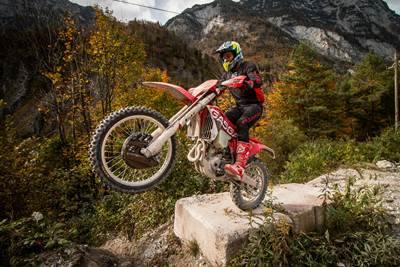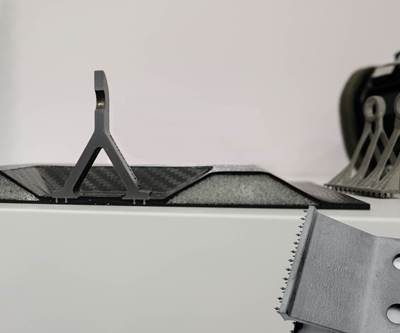FiberJoints innovates composite bolted joints for reduced weight, cost and maintenance
Novel reinforcing patch uses braided sleeve to boost the load-carrying capacity of composite bolted joints.
Connecting composite components is commonly achieved through either adhesive bonding methods or mechanical fasteners. Adhesive bonding stands out as a mechanically efficient means of load transfer across structural elements since stresses are dispersed over the bonded area, resulting in a favorable stress state. Conversely, mechanical fasteners are generally considered less effective for joining composite components because the load transfer occurs locally near the bolt, introducing stress concentrations and making bolted joints less efficient.
The choice of joining method is not always based solely on optimal load transfer — other considerations, such as production constraints and maintenance requirements, also play a crucial role. For example, in certain composite products like wind turbine blades, adhesive bonding emerges as the preferred method for joining shells and webs because typically disassembly isn’t needed before the end of a blade’s operational life. Conversely, for complex structures like airplanes, disassembly for service and regular overhauls is essential. In such cases, bolted joints become a necessity to facilitate inspections.
New bolted fastener system for composites
Figure 1. The FiberJoints patch improves static strength and fatigue endurance of composite bolted joints. Source (All Images) | FiberJoints
Although bolted joining methods offer the advantage of facilitating assembly and disassembly, they often lack efficiency in terms of load transfer in composites. To address this limitation, researchers at Aalborg University in Denmark have developed a novel insert, referred to as a “patch,” aiming to enhance the strength of bolted joints while still retaining the benefits of easy assembly and disassembly. The patch has been designed to effectively redistribute the applied force to the adjacent material (Fig. 1).
This innovative patch has been patented by Aalborg University under the registration WO/2022-053120 and is being commercialized through the company FiberJoints (Aalborg, Denmark). The aim is to improve the overall performance and reliability of bolted joints in composites.
Patch elements and production
The FiberJoints patch comprises three essential elements: 1) a metal ring, 2) a fiber bundle and 3) a braided sleeve (Fig. 2). The choice of materials for these elements can be tailored to meet specific joint requirements. For example, the metal ring may be crafted from high-strength steel, stainless steel or titanium. In certain cases, a polymer ring could be used instead. Similarly, the braided sleeve and fiber bundle can be composed of carbon, glass or aramid fibers. Further, the hole in the metal ring can be customized to be straight, threaded or countersunk, addressing various screw requirements and providing versatility in application. This thoughtful selection of materials and design features enhances the adaptability and effectiveness of the FiberJoints patch in diverse joining scenarios.
Figure 3. FiberJoints patch production steps. The patch shown here can be used for a variety of applications, e.g., fastening points in a marine panel.
Production of the patch involves a series of straightforward steps (Fig. 3). The metal ring is positioned on a mandrel between two washers to secure its placement. Next, a braided sleeve is slid onto the mandrel, covering the metal ring. In the third step, the fiber bundle is wound around the sleeve, forming a fiber ring and establishing a mechanical connection between the sleeve and the metal ring. Following this, the patch assembly is removed from the mandrel, and the sleeve is manipulated to achieve its flat configuration, making it ready for insertion into the composite laminate.
The mechanical strength imparted to the joint by the patch is influenced by various factors, and one crucial determinant is the number of windings executed with the fiber bundle, as depicted in the third step of Fig. 3. A greater number of windings results in a stronger fiber ring and a more robust connection between the sleeve and the metal ring. This enables a customizable approach to control the mechanical strength of the patch and, consequently, its effectiveness in reinforcing the joint.
Load redistribution
Understanding the load-carrying mechanisms of the patch and comparing these to a conventional insert is crucial. Consider a composite laminate subjected to an in-plane force generated by a bolt or pin, as illustrated in Fig. 4. In the “conventional solution,” the metal ring emulates a grommet-type insert where the redistribution of the in-plane force to the adjacent composite laminate relies solely on bearing stresses.
The challenge in this design revolves around minimizing these bearing stresses to remain below certain design allowables while concurrently avoiding unnecessary additions to the overall weight of the structure. This emphasizes the importance of optimizing the load-carrying capacity of the insert and managing the associated stresses to ensure structural integrity and performance within specified design parameters.
Conversely, the load-transferring mechanisms demonstrated by the FiberJoints solution are notably different. The patch facilitates the redistribution of joint load into bearing stresses on top of the hole and tension stresses below the hole. The patch’s unique ability to carry a portion of the applied force through stresses below the hole is concealed in the folding of the sleeve around the fiber ring (bottom image, Fig. 4). The mechanical performance of the patch is primarily governed by the bearing strength of the laminate, as well as the tensile strength of the fiber bundles in the patch’s braided sleeve and within its fiber ring. Through the induction of tensile stress in the fiber bundles, the patch effectively optimizes the utilization of the fiber material, enhancing its load-carrying capacity and overall mechanical performance.
Tests confirming higher load carrying capacity
Figure 5. Static in-plane loaded carbon fiber/epoxy laminate with and without a FiberJoints patch to reinforce the joint.
Numerous tests have been conducted to validate the load-carrying mechanisms of the patch and its associated performance benefits. Tests involved examining carbon fiber/epoxy laminate samples both with and without a patch to reinforce the joint. The carbon fiber/epoxy laminates were constructed using unidirectional (UD) carbon fiber plies in a +45°/0°/-45° stacking sequence and vacuum infused with an epoxy resin. A 10-millimeter bolt was used to introduce the load. The results from in-plane quasi-static loading (Fig. 5) clearly indicate that the patch has a positive and strength-enhancing effect on the joint. On average, the strength gain for this setup is more than doubled compared to an unreinforced joint. This significant increase in strength offers an opportunity to leverage it for weight reduction, subsequently lowering the material cost of a component.
Additional testing has been conducted on glass fiber/epoxy laminates under both static and fatigue loading conditions, as detailed in the technical paper, “Bolted joint method for composites materials using a novel fiber/metal patch…,” published in the January 2024 issue of Composites Part B: Engineering. This investigation discusses the efficiency of load transfer to the adjacent material when normalized with respect to the laminate strength. The load transfer efficiency parameter serves as an indicator of how effectively the adjacent composite material is used, considering the redistribution of the applied joint force. For samples without a patch, a 30% efficiency is attainable. In contrast, samples with patches demonstrate an enhanced efficiency of 60%.
In that same study, similar samples are subjected to tension-tension fatigue loading. Once again, the patch proves to have a positive impact on the mechanical performance of the bolted joint. The load-transfer efficiency is employed as a measure for comparison among the tested configurations. Samples reinforced with a patch exhibit only a 27% fatigue knockdown compared to the fatigue endurance of the laminate material itself. Conversely, not using the patch as joint reinforcement results in an 85% fatigue knockdown. Thus, the FiberJoints patch improves the fatigue performance of composite bolted joints.
Future development
Ongoing development of the FiberJoints technology includes creation of a prepreg-based patch, with prototypes expected to undergo testing later this year. Additionally, the company is engaged in R&D efforts to integrate sensors into the patch, allowing for health monitoring of the bolted joints. This innovation has the potential to significantly reduce maintenance costs by providing real-time data for optimal planning of service intervals.
FiberJoints and Aalborg University are actively seeking collaborations with industry partners and directs companies interested in evaluating FiberJoints patches to https://www.fiberjoints.com/contact.
About the Author
Johnny Jakobsen
Johnny Jakobsen is a mechanical engineer with a focus on composite materials. He earned his master’s degree in 2005 and obtained his Ph.D. in 2008, both from Aalborg University in Denmark, specializing in the failure of sandwich structures. After gaining practical experience in the composites industry, Jakobsen transitioned back to academia as an associate professor. His research shifted toward cure kinetics, residual stresses and draping of fabrics, particularly in applications related to aerospace and wind turbine blades. In 2020, he embarked on a new project, developing a patented composite bolt reinforcement system and recently co-founded the company FiberJoints, which is responsible for commercializing this new technology.
Related Content
Developing milling for CMC because grinding takes too long
Economical processes that can cut machining time by 70% are being tested on aeroengine turbine blade demonstrators by Hufschmied and DLR in the SCANCUT project.
Read MoreSolar-powered photonic cooling enables energy-saving coating
Passive cooling technology can reduce interior temperatures 5-13°C, offering weight, cost and CO2 benefits for cars, construction, aircraft and more.
Read MoreAI-powered robotic solutions support high-mix manufacturing
AI startup offers automation innovations for high-mix, high-variability, manual surface finishing applications.
Read MoreCreating a composite battery insert-stud solution for EV trucks
Bossard worked with an OEM and Tier supplier team to meet tight electrical insulation and packaging tolerances while reducing tooling, molding and assembly costs.
Read MoreRead Next
Thermoset-thermoplastic joining, natural fibers enable sustainability-focused brake cover
Award-winning motorcycle brake disc cover showcases potential for KTM Technologies’ Conexus joining technology and flax fiber composites.
Read MoreHyperjoint: additive metal + composites = stronger, tougher joints
Eliminates drilling holes with lap shear 60% higher than bolted joints and almost twice that of bonded joints.
Read MoreWelding thermoplastic composites
Multiple methods advance toward faster robotic welds using new technology for increased volumes and larger aerostructures.
Read More



























